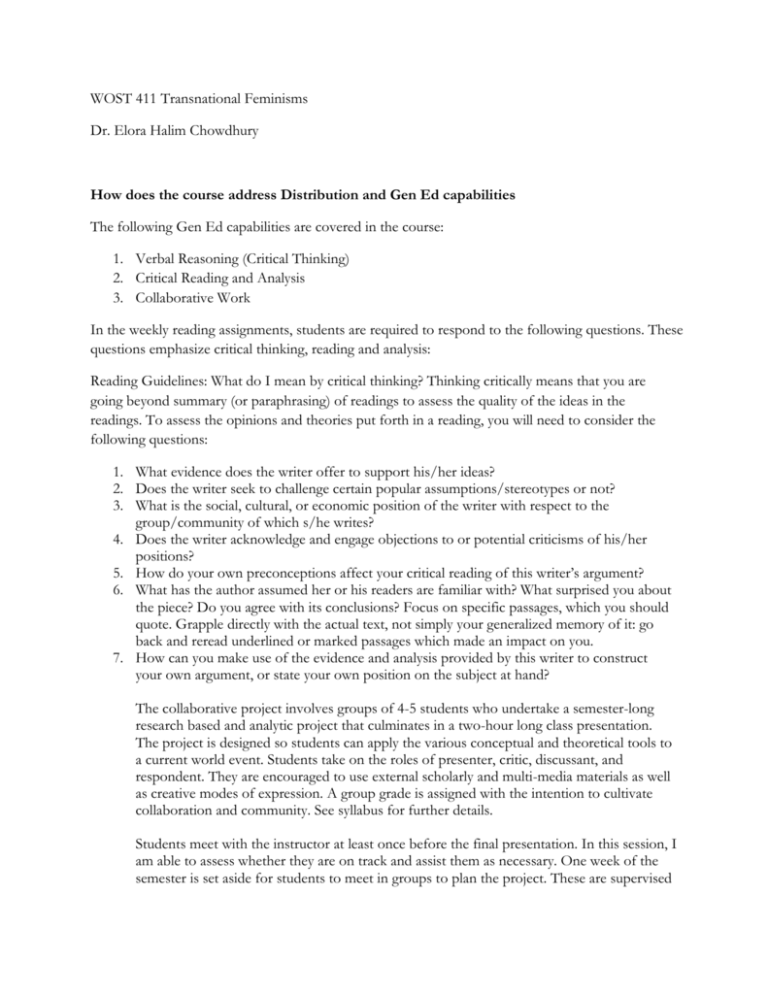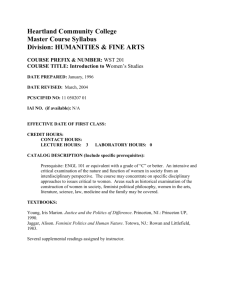Distribution WC WOST411 - Distribution Committee
advertisement

WOST 411 Transnational Feminisms Dr. Elora Halim Chowdhury How does the course address Distribution and Gen Ed capabilities The following Gen Ed capabilities are covered in the course: 1. Verbal Reasoning (Critical Thinking) 2. Critical Reading and Analysis 3. Collaborative Work In the weekly reading assignments, students are required to respond to the following questions. These questions emphasize critical thinking, reading and analysis: Reading Guidelines: What do I mean by critical thinking? Thinking critically means that you are going beyond summary (or paraphrasing) of readings to assess the quality of the ideas in the readings. To assess the opinions and theories put forth in a reading, you will need to consider the following questions: 1. What evidence does the writer offer to support his/her ideas? 2. Does the writer seek to challenge certain popular assumptions/stereotypes or not? 3. What is the social, cultural, or economic position of the writer with respect to the group/community of which s/he writes? 4. Does the writer acknowledge and engage objections to or potential criticisms of his/her positions? 5. How do your own preconceptions affect your critical reading of this writer’s argument? 6. What has the author assumed her or his readers are familiar with? What surprised you about the piece? Do you agree with its conclusions? Focus on specific passages, which you should quote. Grapple directly with the actual text, not simply your generalized memory of it: go back and reread underlined or marked passages which made an impact on you. 7. How can you make use of the evidence and analysis provided by this writer to construct your own argument, or state your own position on the subject at hand? The collaborative project involves groups of 4-5 students who undertake a semester-long research based and analytic project that culminates in a two-hour long class presentation. The project is designed so students can apply the various conceptual and theoretical tools to a current world event. Students take on the roles of presenter, critic, discussant, and respondent. They are encouraged to use external scholarly and multi-media materials as well as creative modes of expression. A group grade is assigned with the intention to cultivate collaboration and community. See syllabus for further details. Students meet with the instructor at least once before the final presentation. In this session, I am able to assess whether they are on track and assist them as necessary. One week of the semester is set aside for students to meet in groups to plan the project. These are supervised in class group meetings where the instructor can guide the students to necessary materials and provide feedback. The final essay can count towards the WPE portfolio. It is a 6-8 page essay where students put a cluster of authors in conversation with one another around a particular theme covered in class. Distribution Area: World Cultures This course meets the General Education Distribution II World Cultures (WC) requirement. Courses in this category invite students to explore the divergent meanings of “culture” in a variety of international, national and local settings, and to learn about complexities of the cultural practices and cultural knowledges that are created by, and that shape, human communities. This course also meets the International Diversity requirement. Goals: Using the methods of verbal reasoning (critical thinking), collaborative work, and critical reading and analysis, the goal of this course is to actively engage students in acquiring interdisciplinary knowledge about feminist thought and praxis. Readings, films, lectures and class discussions will equip students to carefully analyze and understand various feminist theoretical approaches in the past and present. Students are likewise enabled and encouraged to reflect on their own understandings of feminism – as inquiry, identity and analytic lens - and explore the ways their own lives—their own identity, positionality and national/cultural context—connect them to the lives of others. To meet these goals, students will: Critically examine the cultural, historical and political meanings of concepts and trends used to talk about transnational feminism Learn to employ a multidisciplinary analysis of feminist movements and issues that encourages an understanding of the diversity, complexity, and indeterminacy of cultural practices and cultural knowledges. Culture is central to student learning and student engagement as: (1) an analytic concept; and (2) a dynamic, transformable, real-world space for dialogue, debate, and meaningful human connection (rather than a static entity or a fixed ideological position to be assumed). This allows students to consider, for instance, the ways feminism/democratic struggles do, or should, matter to all individuals, communities, peoples and nation-states. For example: Is there a “culture of feminism” in the U.S., in your neighborhood, at this university, nationally? Such questions allow students to deepen their knowledge of the contradictions, ambiguities, and possibilities that constitute what is called feminist struggles across cultures, and enable them to analyze the cultural debates and cultural dilemmas that impact and animate feminist struggles in local, national, and global contexts. Focus on the unique and general historical, political and socioeconomic conditions of the exploitation, destruction, disenfranchisement, and marginalization of communities, peoples, and nations by the material and ideological processes of conquest, colonialism, industrialization, and globalization. Assess various strategies of mobilization and political action for resisting, and preventing exploitation. For example, students will examine various frameworks for collective/individual action in asserting and enacting various feminist principles and action.











